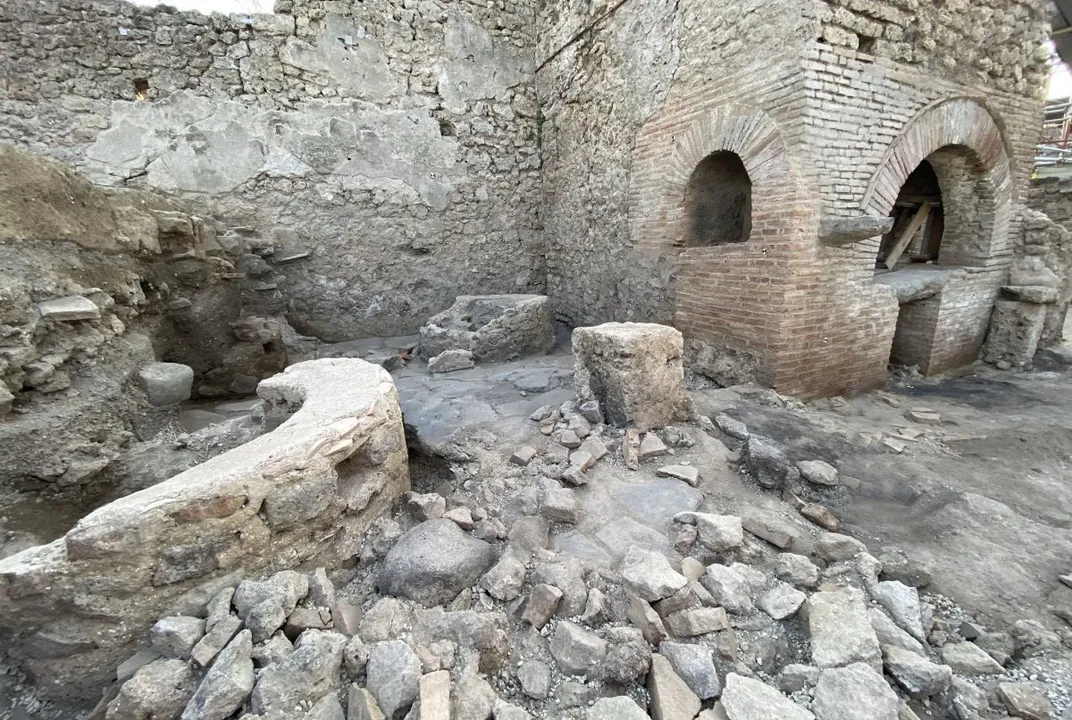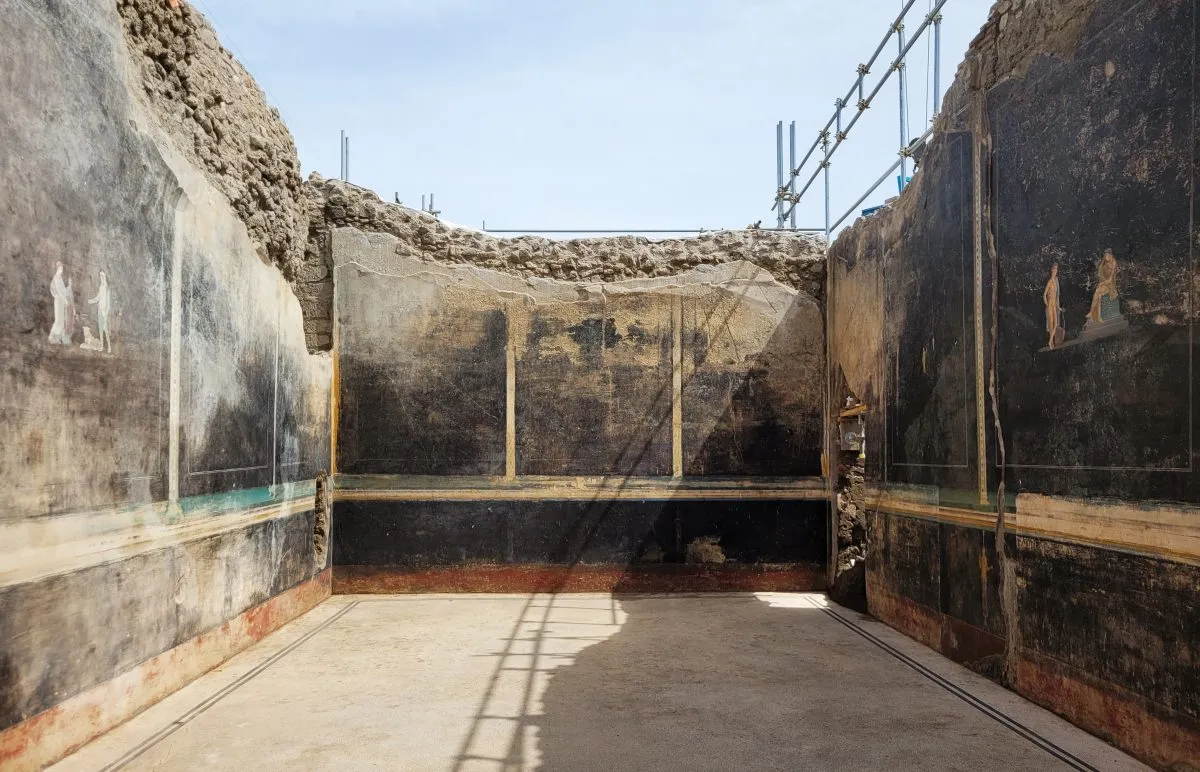Pompeii, Italy’s frozen-in-time Roman city, continues to astonish the world with new and extraordinary discoveries. This archaeological site, one of the most famous and studied in the world, never ceases to reveal hidden treasures beneath the ashes, offering a fresh glimpse into daily life in ancient Rome. Recent excavations have uncovered new details, further enriching our understanding of this lost civilization.

Pompeii: When Time Stopped in 79 A.D.
Pompeii, now an archaeological site located in the Province of Naples, was once a vibrant Roman city, bustling with crowded markets, luxurious villas, and imposing temples… until 79 A.D., when time stopped.
On August 24th, 79 A.D., Mount Vesuvius—a volcano still active today—erupted with devastating power. A column of ashes, pumice, and toxic gases rose into the sky and rained down on Pompeii, burying the city and its inhabitants under a thick layer of volcanic material.
The eruption, which lasted about 24 hours, turned Pompeii into a ghost town, where the buildings, streets, and bodies of its inhabitants were preserved in an extraordinary state until the site was discovered 1,700 years later. This is why Pompeii is often referred to as a city frozen in time.
Today, Pompeii can be visited as an archaeological site where you can walk through the streets of an ancient city, observe ancient villas, and see objects unearthed by archaeologists who are still working on the site. Indeed, Pompeii continues to reveal its secrets: let’s explore the latest discoveries at the archaeological site and what ancient secrets they have uncovered.

The Victims of Regio IX
The volcanic debris that covered the city ensured that the skeletons of Pompeii’s citizens were found in excellent condition. One of the most recent discoveries in this regard is that of two bodies—a man and a woman—found in Insula 10 (which corresponds to modern-day Block 10) within Regio IX, an area that has been undergoing maintenance in recent years due to the risk of collapse. It is precisely these maintenance works that are bringing new secrets of Pompeii to light.
The woman’s body was found on a bed, along with a small treasure of gold, silver, and bronze coins, as well as some jewelry. It seems that the small room where the bed was located had been chosen as a refuge in the hope of waiting out the ashfall.
The Prison Bakery of Pompeii
Among the fascinating recent discoveries in Pompeii is the unveiling of a remarkably well-preserved ancient bakery, located near the site known as the “Prisoners’ Barracks” (Ergastulum). This bakery, unique in its structure and location, provides a rare glimpse into the daily operations of food production in the ancient city. Archaeologists have uncovered a number of ovens, milling stones, and other baking equipment, which together with the remains of burnt loaves of bread, offer an evocative snapshot of life just before the catastrophic eruption.
Interestingly, the bakery’s proximity to the Ergastulum suggests that it may have been connected to a broader network of forced labor, adding a complex layer to our understanding of Pompeian society. This discovery, combined with ongoing restoration efforts, enriches the narrative of Pompeii as a vibrant, yet stratified community, with its social dynamics forever etched in the city’s final moments.

The Black Salon
Regio IX has also recently unveiled the so-called Black Salon, an interior room decorated with paintings depicting scenes from the Trojan War.
The Black Salon gets its name because the paintings are actually graffiti etched on a black background. The inscription “hic et ubique” (here and everywhere), still visible, has captured the world’s attention. It is believed to have been a common expression in Pompeii, used as a kind of good-luck phrase.

The Insula of the Chaste Lovers
In May 2024, the Pompeii Archaeological Park opened the Insula of the Chaste Lovers to visitors. The administration has created an elevated walkway that allows the public to observe the entire insula (which is essentially a small city block) from above. The insula includes:
- The House of the Chaste Lovers: a domus (residence) named after a fresco depicting two lovers sharing a tender kiss. The house is also notable for its well-preserved interiors, with stunning decorations that still retain their original colors. The frescoes in the rooms depict scenes of daily life and myths, offering a glimpse into the private lives and customs of Pompeii’s inhabitants.
- The House of the Painters at Work: a domus where numerous painting tools were found, giving it the name “House of the Painters.” The interior walls feature unfinished frescoes and colors still being prepared, evidence that the eruption caught one or more artists in the midst of their work.
- The House of the Colonnaded Cenacle: a domus named after its peristyle, an inner courtyard surrounded by columns. Here too, frescoes and architectural elements are preserved, allowing us to reconstruct the customs and traditions of Pompeian life.
With its new discoveries and incredible state of preservation, Pompeii offers a unique journey through time. Visiting the archaeological site means immersing yourself in the daily life of a Roman city, admiring its houses, frescoes, and even its inhabitants. Plan your trip to Pompeii with Iamme Ia! to explore this extraordinary heritage without stress, enjoying guided tours and personalized services that will allow you to discover every corner of Pompeii with ease and tranquility.

Explore Sorrento and the Amalfi Coast with Iamme Ia!
Who better to help you navigate this area than Iamme Ia!, your expert companion. Connecting with us is easy. For more information on our tours, to make bookings, or to discuss your upcoming travel plans, please visit our tour pages or contact page on our website.
If you find yourself wandering the charming streets of Sorrento, feel free to stop by our office at Piazza Torquato Tasso 16, where our friendly staff is eager to help you plan your next unforgettable adventure. As a proud Gray Line licensee, Iamme Ia! has been committed since 2014 to not only showcasing the stunning landscapes and rich culture of the Amalfi Coast but also to providing a narrative that weaves together breathtaking views, diverse experiences, and memorable moments.
With Iamme Ia!, your journey through Italy will be more than just a visit—it will be a profound engagement with the heart and soul of the region. Let us turn your trip into an experience of a lifetime.
